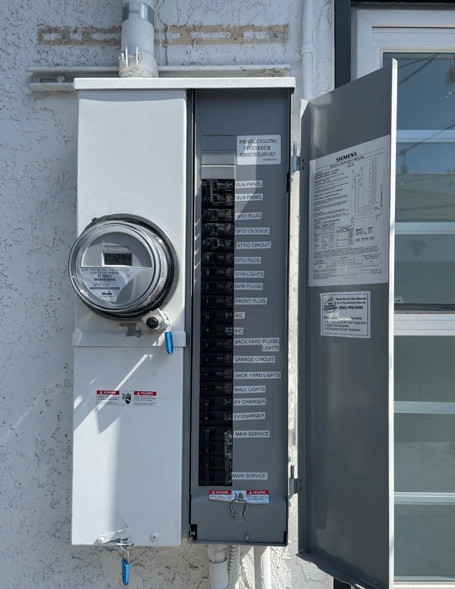How do I find my main electrical service panel?
Follow these steps to locate your panel and understand its components.
Typically, you'll find your home's main amperage inside the main electric panel, on a circuit breaker switch labeled "Main" or "Service Disconnect," attached or very close to your electric meter. On the breaker itself will be a number between 60 and 200.
Step 1: Locate Your Main Electrical Service Panel
The main electrical service panel, often known as the breaker box, is usually found in areas away from main living spaces. Common locations include:
- Basement
- Garage
- Utility room
- Hallway leading to the garage
- Closet
- Exterior walls (especially near the electric meter)
To locate it, look for a gray or metal box mounted on a wall.


In the photo to the left, the electric panel is located inside a garage. The photo below shows an electric panel on an exterior side of a house.
Some homes may also have a smaller subpanel that controls electrical circuits in a garage, workshop, or other outbuilding.
For a visual guide on locating your electrical panel, see this short video from The Spruce.
Step 2: Open the Panel Door Safely
Once you've located the panel:
-
Ensure safety: Before opening, make sure the panel is not locked. If you can't easily open the cover without a tool, don't open it. Do not unscrew any parts or remove any locks or seals.
-
Open the door: Most panels have a hinged door that opens outward. Gently open it to reveal the circuit breakers inside.
The photo below shows the electrical panel with the door open to the right. To the left are two sealed closures with the blue hang tags; there is no need to open these.

If you see any bare wires, do not touch them. Instead, take a photo of them and share with QuitCarbon so we can help you get them repaired.
Step 3: Identify the Main Circuit Breaker
Inside the panel, you'll see multiple switches (circuit breakers). The main circuit breaker controls the electricity supply to your entire home and is usually positioned at the top or bottom of the panel. To identify it:
-
Look for labels: The main breaker is often labeled "Main" or "Service Disconnect."
-
Check the amperage rating: A number indicating the amperage (e.g., 100, 150, 200) is typically displayed on the main breaker. This number represents the maximum electrical capacity of your home's system.
In the following photo, the home has 100 amps of main electric service.

This home has 200 amps of main electric service:

Step 4: Understand the Individual Circuit Breakers
Below the main breaker, you'll find rows of smaller breakers, each controlling power to specific areas or appliances in your home. To interpret them:
-
Read the labels: Each breaker should have a label indicating its designated circuit (e.g., "Kitchen," "Living Room," "Oven"). If labels are missing or unclear, consider creating your own by turning off one breaker at a time and noting which area loses power.
-
Note the amperage: Each breaker has a number (e.g., 15, 20) indicating its amperage rating, which corresponds to the maximum load it can handle. Common ratings include 15-20 amps for general circuits and higher ratings (30–50 amps) for major appliances.
The breakers shown below have 20 or 30 amps each.

